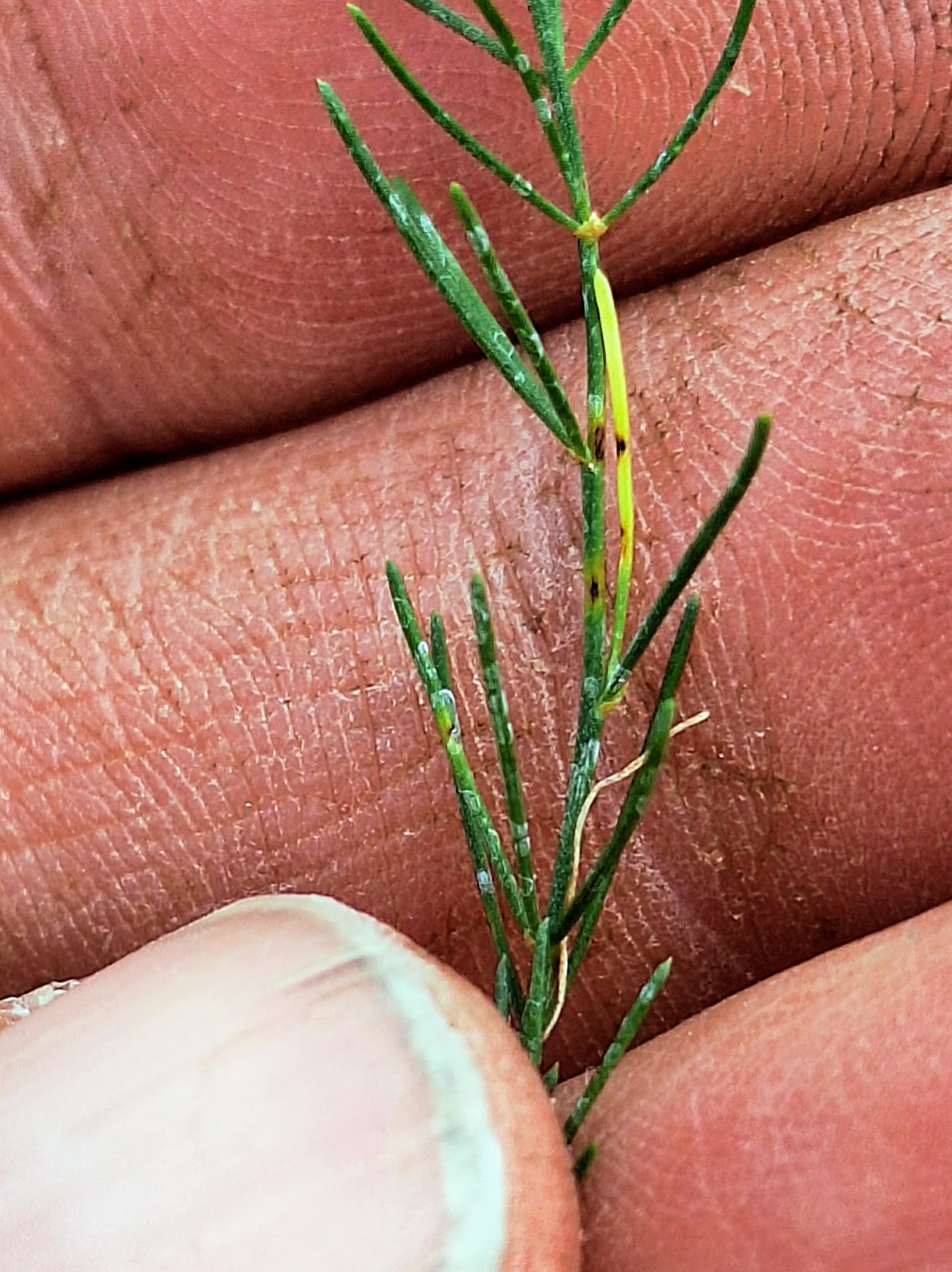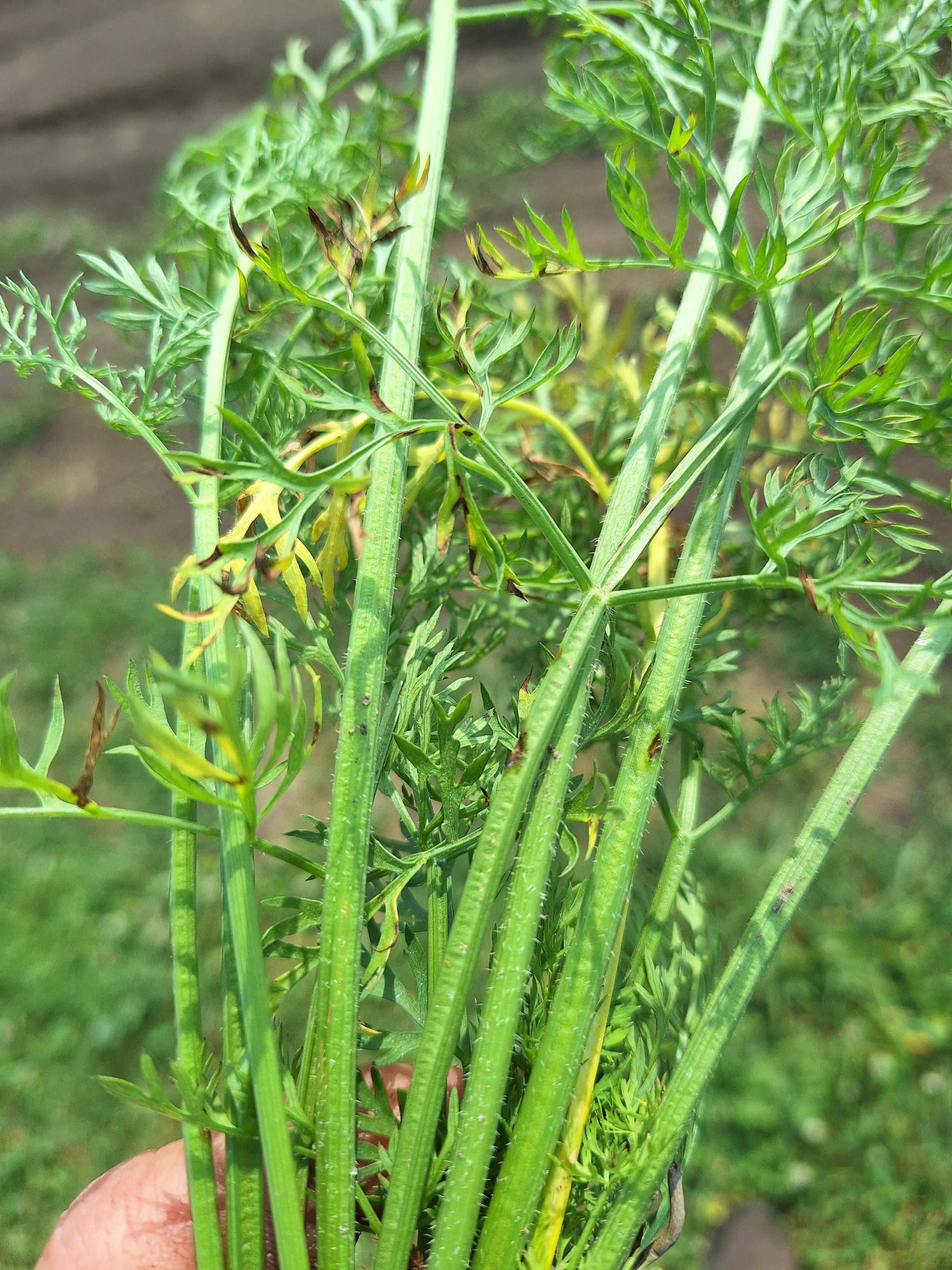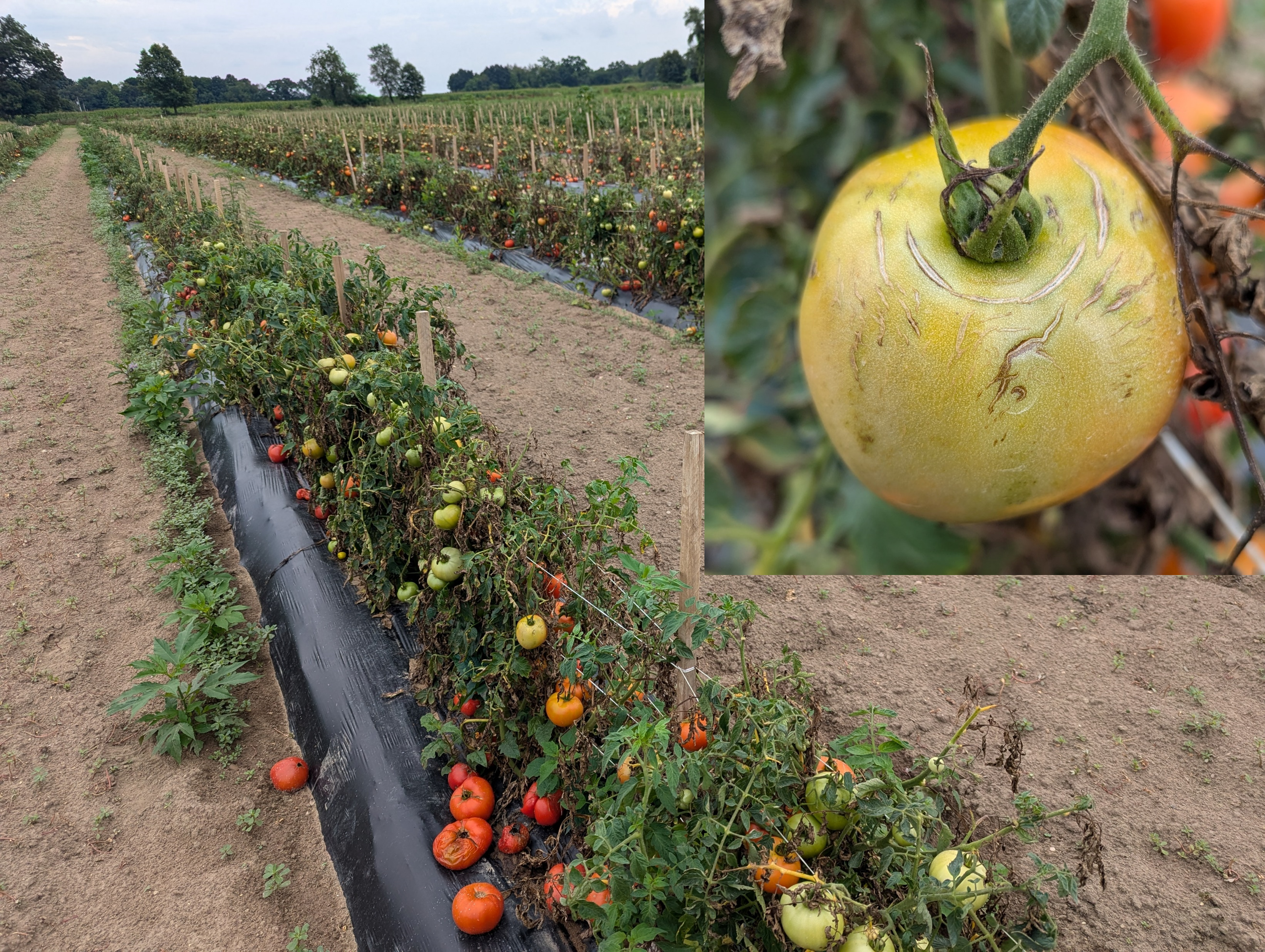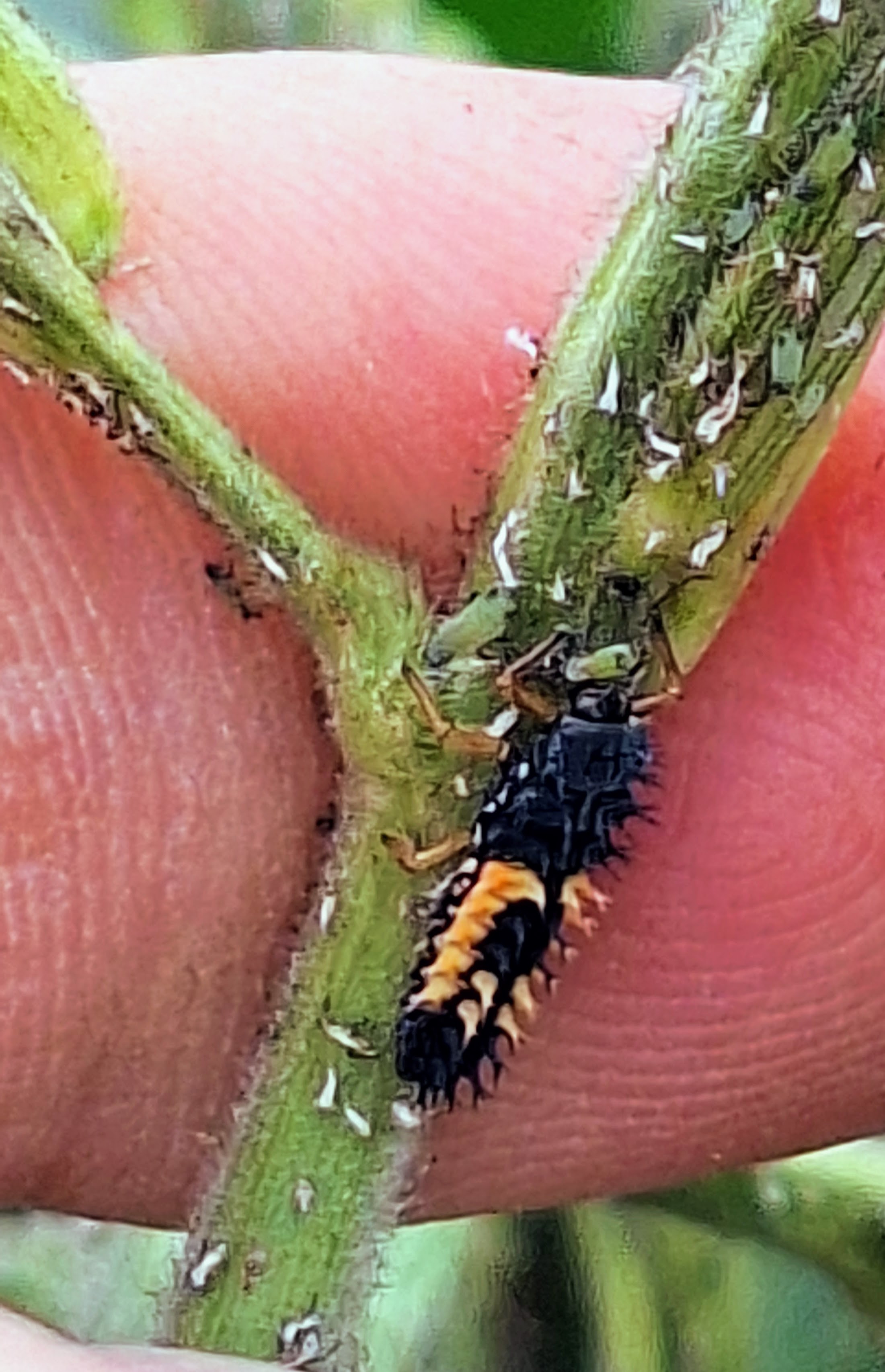Michigan vegetable crop report – August 7, 2024
Consequences from excessive rains, strong sweet corn harvest, cover crops for fall.

Weather
Uneven rain dumps have created very different situations for individual growers, even within the same county, leading to wide-ranging drainage, irrigation and disease management implications.
For the past week, temperatures were above normal with conditions ranging from dry in the western Upper Peninsula to extremely moist in parts of the southern Lower Peninsula. Degree-day totals are slightly behind in the western Upper Peninsula to a week ahead in most of the Lower Peninsula.
The upcoming week’s weather is forecast to be:
- Mostly sunny, dry and cooler Wednesday (Aug. 7). Scattered showers possible Thursday through this weekend to the north. Variably cloudy, cool and mostly dry elsewhere with isolated showers possible this Saturday.
- Cooler than normal temperatures for much of the upcoming week, with highs in the upper 60s to upper 70s through this weekend. Low temperatures generally in the 50s.
- Near normal daily potential evapotranspiration (PET) rates expected this week (average daily values from 0.14 – 0.17 inches).
- Medium range outlooks generally call for a transition from cooler than normal to warmer than normal temperatures with normal to above normal precipitation totals.
- Long lead outlooks continue to call for normal to above normal mean temperatures and precipitation totals.
Cover crops for fall
Many growers are shutting down fields from spring plantings, but in many cases it’s too late to start another crop in its place as a double crop. Cover crops are a great option to cover the soil into winter, and sometimes through winter. The most commonly used cover crop is cereal rye, which overwinters and explodes in growth in the spring. It is a relatively inexpensive cool-season grass, which will not act as a host for most broadleaf vegetable pests. It germinates readily with surface broadcasts or drilling, but higher rates are needed for overhead broadcasts to compensate for seed predation. You can start planting it now and continue through most of the fall. You get more nutrient scavenging and winter annual weed-competition with an earlier planting. A cover crop that fills a similar role is oats. However, oats will not overwinter, which can be a good option for fields that need to be broken into extra early in the spring.
How about some beans and greens with that? Legumes and turnips or radishes can be sown with grasses, but attention should be paid to crop rotations that include beans, peas and brassicas to avoid pest carryover. Hairy vetch is sometimes mixed with rye. Field peas can be sown with oats as they both usually winterkill. Each cover crop has its own personality it will bring to a mix, so be aware of these prior to sowing!
Crop updates
Asparagus
Weather was highly favorable for development of purple spot for the week ending Monday. Nine of 10 monitored sites accumulated at least 15 disease severity values (DSVs) between July 29 and Aug. 5 (sites are monitored by Michigan State University and partnering consultants in Oceana and Mason counties). In a previous report, Mary Hausbeck shared that “The rapid accumulation of DSVs in a relatively short period of time would indicate the need to use a locally systemic fungicide such as Quadris (azoxystrobin), which could be tank mixed with either mancozeb (Roper) or chlorothalonil (Bravo WeatherStik) with each at the full labeled rate.”

Brassicas and greens
Broccoli, kohlrabi, some cabbage, kale and salad mixes of all types are flowing into markets with new plantings being established. All caterpillars and beetles can be found, with thrips as well in some situations. White mold is being reported.
Carrots and celery
For celery, scouts have observed slugs can rasp on petioles in wet weather. Spreadable slug baits including the active metaldehyde (e.g., Deadline Bullets) can provide control (one-day preharvest interval). Applications need to be directed at the soil so as to not contact the crop. The label suggests that to optimize efficacy, soil should be damp or irrigated so slugs are active and consume it. Slugs and snails will often be worse next to moist hangouts, like ditches, so spot treatment is possible.
Foliar disease in carrots is likely to accelerate with the recent weather. For example, 12 and 16 DSVs accumulated between July 30 and Aug. 5 at two west central locations Michigan State University Extension is monitoring. It is a good time to apply a highly effective product.

Cucurbits
All crops are being harvested, and pumpkins are sizing as powdery mildew settles in across the state. There are nutrient deficiencies and fruit rots galore on farms that can’t seem to catch a break from the rain.
Stay vigilant against downy mildew and Phytophthora pathogens. Downy mildew on cucumber has been confirmed in 15 Michigan counties across the major production regions. Michigan State University’s (MSU) spore trapping project continues to confirm the presence of clade 2 of the downy mildew pathogen indicating that cucumbers and melons are likely to become significantly diseased during this year’s outbreak. Mary Hausbeck’s MSU vegetable pathology program has developed short fact sheets that are regularly updated to include the most effective and recommended fungicides that have been shown in years of field trials to be effective against these destructive pathogens.
Phytophthora crown and fruit rot symptoms are likely to increase following some of the recent rains that many areas of the state have experienced. There are helpful factsheets for each cucurbit type. Growers who use these greatly appreciate them.

Fruiting vegetables
Eggplants are going to market now, as well as peppers, tomatoes and okra. Tom-cast models show an increase in DSVs over the last week, which can be used for timing sprays for some fungal diseases, like Alternaria early blight. However, severe bacterial blights can also be found in some fields, and those are managed differently. Rain checking is showing up on fruit.

Pepper maggot is a sporadic pest that can be problematic for some growers. The adult fly lays its eggs into the fruit of peppers (and other solanaceous plants), leaving telltale marks behind where the ovipositor cuts into the skin. The larvae that hatch from the eggs burrow into and feed on the internal tissue, ruining pepper fruit from the inside out. The maggots often will then exit the fruit and fall to the soil to pupate.
A fine mesh insect netting can be used to prevent incoming pepper maggot flies from reaching developing fruit, but will do nothing for flies that emerge from the soil within the barrier. Plastic mulch may also help reduce population numbers by blocking larva from reaching the soil upon exiting the fruit. Reducing local buildup in pepper maggot pressure through crop rotation is another piece of the management puzzle. Some pyrethroids can help to control flies before they are able to lay their eggs (maggots already active inside fruit are protected from insecticide contact).
Potatoes
Some viruses have been reported. Late blight has been detected in two fields in St. Joseph County, Michigan. The genotype is US-23, which remains sensitive to mefenoxam/metalaxyl. How can you irrigate to minimize leaf wetness? One technique is to apply overhead water at a time when the crop would be wet anyway (e.g., early morning), which will allow the foliage time to dry during the day.
Sweet corn
Harvests are coming in strong. It is interesting to see how each market has their favorite, though the variety names are not often posted for consumers to see. Sometimes a moniker is used to describe all varieties in a class, such as “peaches n cream” for bicolors or “silver queen” for whites.
Corn leaf aphids had mostly been killed at two locations that had heavy infestations a week or two ago. There were still some aphids, so it is worth keeping an eye on ears and silks. Beneficials that eat aphids, including ladybug larvae, were quite common. Thankfully, cooler weather will slow population growth.

Corn earworm is present in numbers warranting management. West central scouts reported an uptick in captures, also visible in at least one west central trapping location. So far, huge numbers have not been reported, but keep an eye on traps as things can literally change overnight as August pushes onward. To our south, nightly captures were mostly in the single digits at sites Purdue University and Ohio State University are monitoring. Insect Forecast predicts little to no risk of additional migration through Aug. 12.
|
Corn earworm captures. Total in trap for week1 (avg # per night2) |
||||||||
|---|---|---|---|---|---|---|---|---|
|
Week |
Monroe County |
Washtenaw County |
Oceana County |
Ottawa County |
Lapeer County |
Bay County |
Saginaw County |
Berrien County |
|
8/5 |
- |
- |
6 (0.9) |
28 (4.0) |
- |
1 (0.1) |
1 (0.1) |
4 (0.5) |
|
7/29 |
4 (0.5) |
0 (0.0) |
4 (0.7) |
13 (1.6) |
0 (0.0) |
0 (0.0) |
0 (0.0) |
3 (0.4) |
|
7/22 |
2 (0.4) |
0 (0.0) |
1 (0.1) |
0 (0.0) |
- |
1 (0.1) |
0 (0.0) |
4 (0.5) |
|
7/15 |
0 (0.0) |
1 (0.1) |
8 (1.1) |
15 (1.7) |
2 (0.3) |
0 (0.0) |
- |
- |
|
7/8 |
0 (0.0) |
2 (0.2) |
8 (1.1) |
14 (2.0) |
- |
- |
- |
- |
|
6/30 |
- |
- |
5 (1.0) |
30 (6.0) |
- |
- |
- |
- |
|
6/23 |
- |
- |
2 (1.0) |
- |
- |
- |
- |
- |
|
1Total number collected since last trap check; 2The total number divided by the number of nights since the last trap check. |
||||||||
Ohio State University noted they are starting to see damage from fall armyworm.
The time for worrying about western bean cutworm is passing. Western bean cutworm captures declined at most locations MSU Extension is monitoring. Ohio State reported the peak is passing to our south.
|
Western bean cutworm captures. Total in trap for week1 (avg # per night2) |
|||||||
|---|---|---|---|---|---|---|---|
|
Week |
Monroe County |
Washtenaw County |
Oceana County |
Ottawa County |
Saginaw County |
Bay County |
Berrien County |
|
8/5 |
- |
- |
5 (0.7) |
15 (2.1) |
16 (2.3) |
3 (0.4) |
6 (0.85) |
|
7/29 |
0 (0.0) |
1 (0.1) |
5 (0.8) |
40 (5.0) |
19 (2.7) |
6 (0.85) |
5 (0.7) |
|
7/22 |
2 (0.4) |
2 (0.3) |
17 (2.1) |
65 (16.2) |
352 (50.2) |
3 (0.4) |
1 (0.1) |
|
7/15 |
6 (0.7) |
26 (3.7) |
12 (1.7) |
190 (21.1) |
133 (19) |
- |
- |
|
7/8 |
5 (0.7) |
29 (3.6) |
3 (0.4) |
127 (18.1) |
26 (3.7) |
- |
- |
|
6/30 |
- |
- |
0 (0.0) |
11 ( 2.2) |
5 (0.7) |
- |
- |
|
6/23 |
- |
- |
0 (0.0) |
- |
5 (0.7) |
- |
- |
|
1Total number collected since last trap check; 2The total number divided by the number of nights since the last trap check. |
|||||||
Earworm can be managed with pyrethroid, diamide and spinosyn insecticides. Pyrethroids are effective when moth pressure is not high, and include Hero, Ambush/Pounce, Asana, Baythroid, Brigade, Mustang Maxx and Warrior. Products with the diamide chlorantraniliprole (Besiege, Vantacor, Coragen) or the spinosyn spinetoram (Radiant, Intrepid Edge) are effective options for periods with high pressure. Spraying can be discontinued once corn has 90% brown silks, as it’s the green silks that attract egglaying females.
Nutrient management survey
Soil nutrient deficiencies that limit crop yield are often foremost on farmer’s minds but nutrient excesses, especially phosphorus and nitrogen, seem to grab the headlines. Michigan State University Extension is asking farmers from all types of production systems to help identify practices they use by filling out a brief anonymous online survey describing soil conditions and approaches used for soil phosphorus and nitrogen management. Read more information and access the survey here.
Produce food safety On-Farm Readiness Reviews
Schedule an On-Farm Readiness Review (OFRR) today for a 2-hour educational visit that takes place during the harvest season and is meant to be casual and low stress! Everything discussed during an OFRR is confidential and focused on ways you can reduce your own risks in relation to produce safety. There is no pressure to take our advice either, we are just here to support you in your produce safety efforts!
Events
- Aug. 8, 7-8 a.m., Field Crops Virtual Breakfast Series: MSU Diagnostic Lab Topics
- Aug. 8, Potato Field Day at the Montcalm Research Center, Lakeview, MI
- Aug. 12, Small Farms Conference, Benzonia, MI
- Aug. 13, Farming for the Future Field Day at the West Central Michigan Research and Extension Center, Hart, MI.
- Aug. 15, 7-8 a.m., Field Crops Virtual Breakfast Series: Field Crops Nematode Update
- Aug. 20, 6-8 p.m., Veggie Vibes at SWMREC
- Aug. 20, Bean and Beet Day at the Saginaw Valley Research and Extension Center, Frankenmuth, MI
- Aug. 22, 7-8 a.m., Field Crops Virtual Breakfast Series: Lime Recommendations for Field Crops
- Aug. 22, Summer Bus Tour and Annual Field Day at the Northwest Michigan Horticulture Research Center, Traverse City, MI
- Aug. 27, Drone Demonstration for Pest Management Meeting at the Northern Farm Market, Bruce Twp, MI
- Aug. 29, 7-8 a.m., Field Crops Virtual Breakfast Series: Maximizing Wheat Yield Potential
- Sept. 5, 7-8 a.m., Field Crops Virtual Breakfast Series: Drought-Proofing Agriculture with Drainage Water Recycling
- Sept. 5, 3-7 p.m., Organic Vegetable Production Workshop & Crop Walk, MSU Tollgate Center, Novi, MI
- Sept. 5, Long-Term Agroecosystems Research Field Day at the W. K. Kellogg Biological Station.
- Sept. 12, 7-8 a.m., Field Crops Virtual Breakfast Series: Grain Marketing
- Sept. 17, 6-8 p.m., Veggie Vibes at SWMREC
- Sept. 19, 7-8 a.m., Field Crops Virtual Breakfast Series: Late Season Weed Control
- Sept. 23, Field Day at the Trevor Nichols Research Center, Fennville, MI
This work is supported by the Crop Protection and Pest Management Program [grant no. 2021-70006-35450] from the USDA National Institute of Food and Agriculture. Any opinions, findings, conclusions, or recommendations expressed in this publication are those of the author(s) and do not necessarily reflect the view of the U.S. Department of Agriculture.



 Print
Print Email
Email

